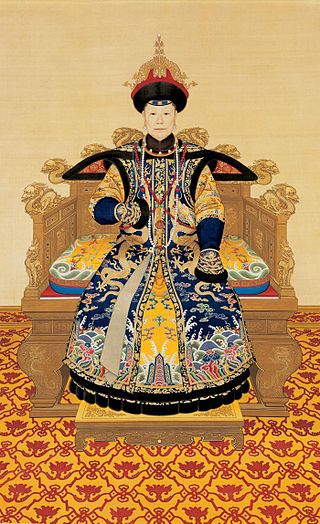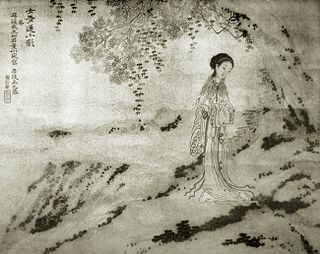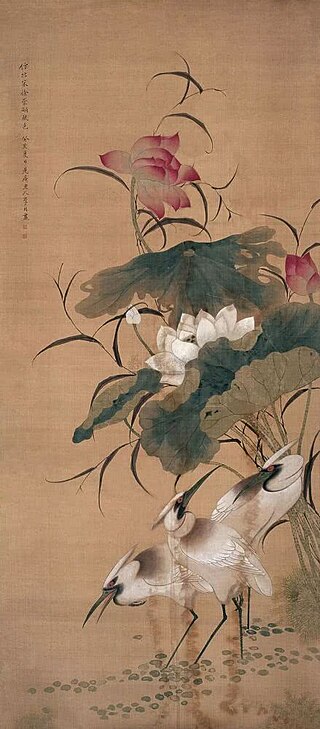Related Research Articles
Wang Wei, also known by her courtesy name Xiuwei, was a Chinese Yiji, poet, and traveller during the late Ming dynasty.

Empress Xiaoshengxian, of the Manchu Bordered Yellow Banner Niohuru clan, was a posthumous name bestowed to the consort of Yinzhen, the Yongzheng Emperor and mother of Hongli, the Qianlong Emperor. She was honoured as Empress Dowager Chongqing during the reign of her son and posthumously honoured as empress, although she never held the rank of empress consort during her lifetime.
Ah Toy (Chinese: 亞彩; Sidney Lau: Aa3 Coi2; 18 May 1829 – 1 February 1928) was a Chinese American sex worker and madam in San Francisco, California during the California Gold Rush, and the first Chinese sex worker in San Francisco. Arriving from Hong Kong in 1848, she became the best-known Asian woman in the American frontier.
Liu Qingyun, courtesy name Guxiang, was a Chinese playwright and poet. She has been described as "the most prolific woman playwright of the nineteenth century".

Fang Shengdong was a late Qing dynasty revolutionary, He was killed during the Second Guangzhou Uprising.
Fang Weiyi, was a Chinese poet, calligrapher, painter and literature historian.
Huang Lü was a Chinese scientist. She was the first woman in China to work with optics and photographic images.
Qiu Ersao, was a Chinese rebel and military commander during the Taiping Rebellion. Originally a religious leader within the Tiandihui, she later had 500 female soldiers under her command.
Hu Jiumei (1830–1856) was a Chinese rebel during the Taiping Rebellion. A leading follower of Hong Xiuquan, she was known as one of the "Three Hu's".

Dong Xiaowan (1624–1651), also known as Dong Bai, was a Chinese Yiji, poet and writer, also known by her pen name Qinglian.
Cao Zhenxiu was a Chinese calligrapher. She was from 1782 married to the official and calligrapher Wang Qisun. She was known as the best female calligrapher in China of her time, and it was common for those ordering calligraphy from her spouse to order from her as well.
Gu Mei, better known by her art name Gu Hengbo, also known as Xu Mei and Xu Zhizhu after her marriage, was a Chinese Yiji, poet and painter. She received the title "Lady (furen)" from the early Qing court, and often addressed as "Lady Hengbo" in Qing writings.
Cai Han, was a Chinese landscape painter. She was the concubine of the painter Mao Xiang and, with his other concubine Jin Yue, she was commissioned by him with the task of producing paintings as gifts to his guests; they became known as "The Two Painters of the Mao Family".
Ding Yu, was a Chinese painter. She was married to the painter Zhang Pengnian (1761–1818) and was known for her portrait paintings in the Western style.

Yun Zhu or Wanglan Yun Zhu aka Adept of the Lotus Lake was a Qing dynasty poet, painter, anthologist and moralist. She gathered together thousands of poems written by hundreds of women.
Events from the year 1872 in China.
Lin Yining, courtesy name Yaqing, was a Chinese poet active during the Qing dynasty. A founding member of the Banana Garden Poetry Club, Lin Yining was also an avid painter and composer.

The Eight Beauties of Qinhuai, also called the Eight Beauties of Jinling, were eight famous Yiji or Geji during the Ming-Qing transition period who resided along the Qinhuai River in Nankin. As well as possessing great beauty, they were all skilled in literature, poetry, fine arts, dancing and music.

Li Yin, also known by her courtesy name Jinsheng (今生) and her art names Shi'an (是庵) and Kanshan Nüshi, was a Chinese painter, poet, and calligrapher during the late Ming and early Qing dynasties, noted for her flowers and birds. Her artwork was sought after in her lifetime, resulting in as many as forty imitators in her area producing fakes of her works.
References
- Lily Xiao Hong Lee; Clara Lau; A.D. Stefanowska (17 July 2015). Biographical Dictionary of Chinese Women: v. 1: The Qing Period, 1644-1911. Taylor & Francis. ISBN 978-1-317-47587-3.
- ↑ Sanders, Graham (2017-01-04), Szonyi, Michael (ed.), "History of Premodern Chinese Literature", A Companion to Chinese History (1 ed.), Wiley, pp. 221–234, doi:10.1002/9781118624593.ch18, ISBN 978-1-118-62460-9 , retrieved 2024-02-08
- ↑ Lily Xiao Hong Lee; Clara Lau; A.D. Stefanowska (17 July 2015). Biographical Dictionary of Chinese Women: v. 1: The Qing Period, 1644-1911. Taylor & Francis. ISBN 978-1-317-47587-3.
- ↑ BERG, DARIA (2007), "Negotiating gentility: The Banana Garden poetry club in seventeenth-century China", The Quest for Gentility in China, Routledge, doi:10.4324/9780203938232-13/negotiating-gentility-banana-garden-poetry-club-seventeenth-century-china-daria-berg, ISBN 978-0-203-93823-2 , retrieved 2024-02-08
- ↑ Idema, Wilt; Grant, Beata (2004-12-08), "The Banana Garden Poetry Club", The Red Brush, Harvard University Asia Center, pp. 471–495, ISBN 978-1-68417-394-5 , retrieved 2024-02-08
- ↑ Robertson, Maureen (1997-04-01), "7 Changing the Subject: Gender and Self-inscription in Authors' Prefaces and "Shi" Poetry", 7 Changing the Subject: Gender and Self-inscription in Authors' Prefaces and "Shi" Poetry, Stanford University Press, pp. 171–218, doi:10.1515/9780804765916-010/pdf?licensetype=restricted, ISBN 978-0-8047-6591-6 , retrieved 2024-02-08